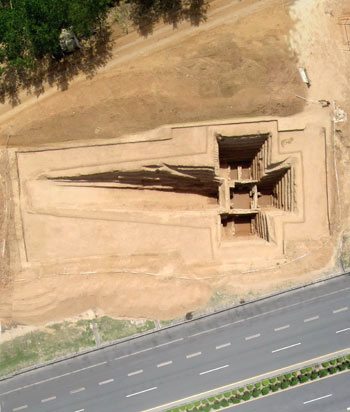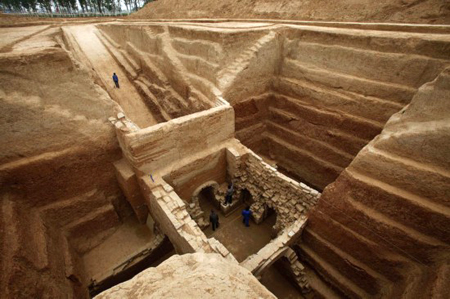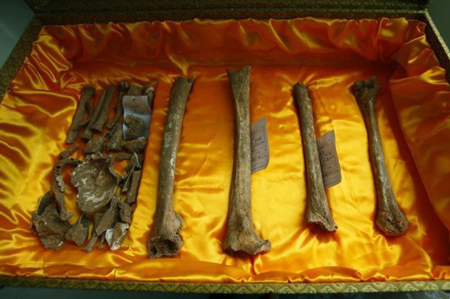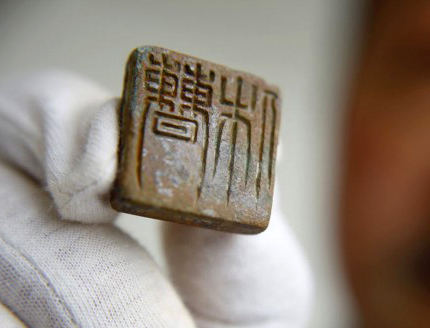Graveyards of the Eastern Han Mausoleums and an Aristocratic Tomb of the Wei Excavated in Luoyang, Henan
The Second Luoyang Team of Archaeological and Cultural Relics conducted an survey and drilling in an area of 345.9 thousand square meters in the vicinity of the Mangshan Mountain royal tombs from February 2009 through May 2010. Together with the area covered by the previous survey, the total area surveyed now reaches 472.8 thousand square meters. In this vast area, 177 tombs datable to the Eastern Han, Wei, Western Jin, Northern Wei, Tang, and Song have been excavated, including two large aristocratic tombs of the Eastern Han and one large tomb built for the Wei aristocrat Cao Xiu. The excavation covers an area of 23 thousand square meters, among which 16.2 thousand square meters belong to the excavated Eastern Han and Wei graveyards.

1. New discoveries at the royal graveyard of the Eastern Han mausoleums
The excavation focuses on three locations of remains, including Dahanzhou, Yuzhong, and the most significant Zhucang. The Zhucang location of remains is situated west of Zhucang Village, Pingle Town, Mengjin County, covering the central area of the royal graveyard which contains tomb M722 and tomb M707 as well as the northern section of the graveyard which contains the two accompanying tombs M708 and M709. The working area of the excavation measures 1800 meters long and 30 to 50 meters wide. From March 2009 through May 2010 an area of 12 thousand square meters were excavated and 52 tombs were cleared.
Royal Graveyard Site of Tomb M722 at Zhucang:The severely damaged tumulus is round in ground plan. The original tumulus under the present ground is 136 meters in diameter. The overall configuration of the tomb that has a square pit and an arch shows a shape similar to the graph甲. The tomb chamber pit measures 25 meters long from east to west and 28.8 meters wide from south to north, while the passageway measures 50 meters long and 8.8 to 10.4 meters wide.
Inside the graveyard have been found 4 walls, the northern and western sections of which are relatively well preserved. To the east of the east wall has been found a ditch. The archaeologists excavated the west and east walls as well as part of the ditch. The foundation of the walls is normally 2.8 meters wide. The graveyard is roughly a square in plan with each side measuring 420 meters. The tumulus is located in the west of the yard, while most of the architectural remains are situated in the east and south of the yard. They are mainly foundations made of pound-earth or courtyard-related buildings.
In addition, a gallery, a large pound-earth foundation, and a courtyard were excavated. From east to west the T-shaped gallery is 69 meters long and 14 meters wide while from north to south it is 35 meters long and 11 meters wide. It is well preserved showing clear signs of pillar network, partition walls, and surrounding ditch. The pound-earth foundation is rectangular in shape, measuring 46 meters long and 31.2 meters wide. In its surroundings are relatively well-preserved pebble apron, passageway, and steps. The courtyard site is 32 meters long and 21.1 meters wide. To the two sides of the patio are 7 groups of houses. Some of the fragmentary walls are as tall as 70 centimeters. According to the relative positions of the large pound-earth foundation, the courtyard, and the tumulus and on the basis of the texts, it has been hypothesized that they may have been the Resting Hall (qindian) and the Hall for Daily Life (biandian), or alternatively, the Resting Hall and the Administration Center (yuanxing).
To the west of the graveyard of tomb M722 is the Zhucang graveyard of tomb M707. The diameter of the original tumulus measures 86 meters, but the surviving tumulus measures only 50 meters in diameter. This mausoleum is a 甲-shaped structure with cloisters. Its chamber measures 23 meters long and 18 to 19 meters wide, while its passageway is 40 meters long and 8.8 to 13.6 meters wide. Although no wall remains have been found, a large pound-earth foundation and a courtyard have been discovered to the east of the tumulus. The foundation measures 43.2 meters long from east to west and the damaged width from north to south is 28.8 meters. The courtyard is poorly preserved with some flooring bricks found inside. The foundation may have been the Resting Hall and the courtyard may have been used as a mortuary temple or a dormitory. The graveyard of the accompanying tombs M708 and M709 is an enclosed courtyard.
The graveyard sites of M722 and M707 at Zhucang are well preserved and their composition can be clearly reconstructed. They may have been the royal graveyard sites of the middle or late Eastern Han dynasty. Following the discovery of the Eastern Han graveyard at Baicaopo along the Zhengxi railway, what are found at Zhucang represents another important discovery in the field of Eastern Han mausoleum archaeology.

2. New Discovery of Aristocratic Tombs of the Wei
177 ancient tombs were excavated, datable mainly to the Eastern Han, Wei, Western Jin, Northern Wei, Tang, and Song dynasties. Among the three large tombs, two are located to the south of Dahanzhong (numbered DM1 and DM4) and one is located to the west of Zhucang (ZM44). In between the Dahanzhong site of the Eastern Han royal graveyard and Zhucang tomb M722, Zhucang tomb ZM44 is located to the southeast of Salipu Village, Songzhuang Town, Mengjin County.
The tomb is a multiple-chambered structure with a long ramp and a brick arch. It includes, structurally, the ramp, passageway, front chamber, north side chamber, south double chambers, and back chamber. The constructing method of the tomb consists of excavating the pit and building the arch on top of the pit. The plan of the pit is十-shaped, 50.6 meters long from east to west, 21.1 meters wide from south to north, and 10.5 meters deep. In the pit, there are 7 steps leading into the chamber.
The total length of the ramp is 35 meters, in the middle of which are stairways. The passageway is located to the west side of the ramp. It is arched, square in shape, 2.8 meters long, 1.25 meters wide, and 2.1 meters high。The first sealing door at the beginning section of the ramp is made of bricks. It had long been destroyed and only a layer of stacked fan-shaped bricks have survived. Inside the passageway is the second sealing door which is made of wood. On the two side walls can still be seen the sockets and traces of plaster.
To the west of the passageway is the horizontal, rectangular-shaped, arched front chamber. It is 4.25 meters long from south to north and 3.5 meters wide from east to west. The arch reaches 2.6 meters. To the east of the chamber and parallel to the passageway is the side chamber. It is rectangular in shape, arched, 2.4 meters long, 1.45 meters wide, and 1.9 meters high.
The juxtaposed south double side chambers are almost identical in configuration. The south one is rectangular in shape, arched, 3.6 meters long, 1.65 meters wide, and 2.8 meters high, while the north one is square in shape, arched, 3.6 meters in length and width. Its arch reaches 1.75 meters.
The back chamber is built to the west of the front chamber. It is a rectangular and arched structure, measuring 3.55 meters long, 2 meters wide, and 2.8 meters high.
From the front chamber and the side chambers have been found some fragmentary human skeletons. They belong to one 50ish male and one 40ish female respectively. There are some traces of coffins and skeletons found in the north side chamber. It has been hypothesized that three people were buried inside the tomb.

Due to the robbery, only a small amount of burial objects have been discovered from the tomb, including pottery, bronze, iron, and gold-silver objects. The potteries are mainly jars with four ears, bowls, plates, cosmetic boxes, and ear cups. Major bronzes include belt hooks, clappers, studs, while iron objects include nails, hooks, mirrors, and knives. From the north section of the back chamber has been found a bronze seal with tile-shaped handle. Each side measures 2 centimeters. The seal is carved with two seal characters reading Cao Xiu(曹休). Moreover, a finely made gilt bronze belt hook has been found in the front chamber.

The personal seal found from the tomb provides a solid evidence for identifying the tomb occupant.
The burial objects and the tomb configuration of the Cao Xiu tomb establish an important matrix for periodizing the tombs of the Eastern Han and Wei. The 4 mausoleums, 3 large tombs, and 4 large graveyards that have been excavated are significant discoveries with respect to both the comprehensive study of the cultural morphology of the mausoleums and graveyards of varied times in Mangshan mountain region and the periodization of the tombs and remains in the same region. (Translator: Wang Yudong)

